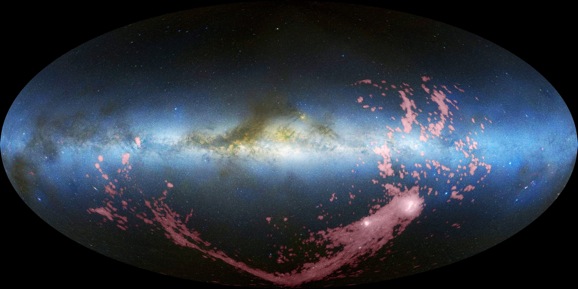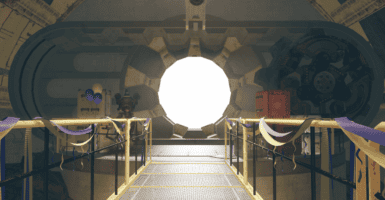At The Edge Of The Galaxy New Stars Are Being Born
This article is more than 2 years old
 There’s some cool stuff happening in space. That’s true in a general sense, but scientists have recently discovered our best look yet at the process of stars being born at the edge of our galaxy, which is exciting. A gas stream from another, nearby galaxy has collided with our own, and the result is brand spanking new stars to brighten up the night sky, unless you live in a city, then you’re just lucky to see a star at all, what with all the light pollution.
There’s some cool stuff happening in space. That’s true in a general sense, but scientists have recently discovered our best look yet at the process of stars being born at the edge of our galaxy, which is exciting. A gas stream from another, nearby galaxy has collided with our own, and the result is brand spanking new stars to brighten up the night sky, unless you live in a city, then you’re just lucky to see a star at all, what with all the light pollution.
Astronomers have now identified the enormous gas flow as coming from the Magellanic Clouds, which are the nearest two galaxies that orbit around the Milky Way. When the gas collided with the gas in our own solar system, they formed the new stars. Since they’re so young and near, scientists can observe them more readily, and the results have yielded some stirring news.
Dana Casetti-Dinescu, from Souther Connecticut State University says, “This is the one and only galaxy interaction we can model in very much detail…For more distant systems that interact, we don’t have the wealth of information.”
There are roughly two-dozen galaxies that orbit our own, but the Magellanic Clouds are by far the closest and the brightest. The Large Magellanic Cloud is 160,000 light years from Earth, which is practically right around the corner, while the smaller one is 200,000 light years away, and scientists believe they also orbit each other. In the 1970s, astronomers discovered the gas stream trailing the galaxies, oddly enough titled The Magellanic Stream, or the Leading Arm, which stretches more than 500,000 light years. No one has ever found any stars in this gas, until now.
Using Chile’s Walter Baade telescope at the Las Campanas Observatory, the astronomers were able to identify six new blue stars in the stream, near the edge of the galaxy. Five of the six stars are roughly 60,000 light years from the center of the Milky Way, but the sixth is the most interesting to observers. At 130,000 light years from the center, it is hanging out beyond the bounds of the galaxy’s stellar disk, and has a “spectral type of O6,” which means that is burns at 44,000 kelvins. Born between one and two million years ago, this kind of star burns brightly, but will burn out quickly. The Magellic gas hits the hot gas halo of the Milky Way, and the resulting impact creates this kind of star with a truncated life span.
Believed to exist for decades, the discovery of these new stars, so close and with such a good view, provide insight for astronomers. With such a roadmap, they now have a look a process that has been happening since ancient times, where smaller, gas rich galaxies collided to form larger ones like the Milky Way.













